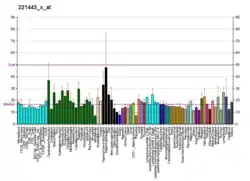Prolactin-releasing peptide
Prolactin-releasing peptide (PrRP) is a peptide hormone that in humans is encoded by the PRLH gene.[5] PrRP stimulates prolactin (PRL) release and regulates the expression of prolactin through binding to the prolactin-releasing peptide receptor (GPR10).[6]
Description
PrRP has 20 amino acids, and is a member of the RFamide peptide family.
During the discovery process, PrRP was found to be a ligand for an orphan G-protein coupled receptor (GPR 10). Preliminary in vitro studies showed it to stimulate the secretion of prolactin from lactotropic cells, hence its name. Now, however, the function of PrRP in the brain is understood in terms of negative regulation of appetite.[7]
PrRP is produced by noradrenergic neurons A1 and A2 in the solitary nucleus, and also by neurons in the hypothalamus.[7]
References
- GRCh38: Ensembl release 89: ENSG00000071677 - Ensembl, May 2017
- GRCm38: Ensembl release 89: ENSMUSG00000090550 - Ensembl, May 2017
- "Human PubMed Reference:". National Center for Biotechnology Information, U.S. National Library of Medicine.
- "Mouse PubMed Reference:". National Center for Biotechnology Information, U.S. National Library of Medicine.
- "Entrez Gene: PRLH prolactin releasing hormonel".
- Langmead CJ, Szekeres PG, Chambers JK, Ratcliffe SJ, Jones DN, Hirst WD, Price GW, Herdon HJ (October 2000). "Characterization of the binding of [(125)I]-human prolactin releasing peptide (PrRP) to GPR10, a novel G protein coupled receptor". Br. J. Pharmacol. 131 (4): 683–8. doi:10.1038/sj.bjp.0703617. PMC 1572376. PMID 11030716.
- Brunton, Paula; Russell, John (2015). Physiology of Reproduction (Fourth ed.). Academic Press. doi:10.1016/C2011-1-07288-0. ISBN 978-0-12-397175-3. Retrieved April 29, 2020. (This extract is more helpful.)
Further reading
- Hinuma S, Onda H, Fujino M (1999). "The quest for novel bioactive peptides utilizing orphan seven-transmembrane-domain receptors". J. Mol. Med. 77 (6): 495–504. doi:10.1007/s001090050403. PMID 10475064. S2CID 19633923.
- Lagerström MC, Fredriksson R, Bjarnadottir TK, Schiöth HB (2006). "The ancestry of the prolactin-releasing hormone precursor". Ann. N. Y. Acad. Sci. 1040: 368–70. doi:10.1196/annals.1327.064. PMID 15891064. S2CID 45949972.
- Hinuma S, Habata Y, Fujii R, et al. (1998). "A prolactin-releasing peptide in the brain". Nature. 393 (6682): 272–6. doi:10.1038/30515. PMID 9607765. S2CID 4306854.
- Fujii R, Fukusumi S, Hosoya M, et al. (1999). "Tissue distribution of prolactin-releasing peptide (PrRP) and its receptor". Regul. Pept. 83 (1): 1–10. doi:10.1016/S0167-0115(99)00028-2. PMID 10498338. S2CID 45945978.
- Zhang X, Danila DC, Katai M, et al. (2000). "Expression of prolactin-releasing peptide and its receptor messenger ribonucleic acid in normal human pituitary and pituitary adenomas". J. Clin. Endocrinol. Metab. 84 (12): 4652–5. doi:10.1210/jc.84.12.4652. PMID 10599733.
- Yasui Y, Yamaguchi M, Jikihara H, et al. (2002). "Expression of prolactin-releasing peptide in human placenta and decidua". Endocr. J. 48 (3): 397–401. doi:10.1507/endocrj.48.397. PMID 11523913.
- Takahashi K, Totsune K, Murakami O, et al. (2003). "Expression of prolactin-releasing peptide and its receptor in the human adrenal glands and tumor tissues of adrenocortical tumors, pheochromocytomas and neuroblastomas". Peptides. 23 (6): 1135–40. doi:10.1016/S0196-9781(02)00046-3. PMID 12126742. S2CID 24182099.
- Strausberg RL, Feingold EA, Grouse LH, et al. (2003). "Generation and initial analysis of more than 15,000 full-length human and mouse cDNA sequences". Proc. Natl. Acad. Sci. U.S.A. 99 (26): 16899–903. doi:10.1073/pnas.242603899. PMC 139241. PMID 12477932.
- Gerhard DS, Wagner L, Feingold EA, et al. (2004). "The Status, Quality, and Expansion of the NIH Full-Length cDNA Project: The Mammalian Gene Collection (MGC)". Genome Res. 14 (10B): 2121–7. doi:10.1101/gr.2596504. PMC 528928. PMID 15489334.




